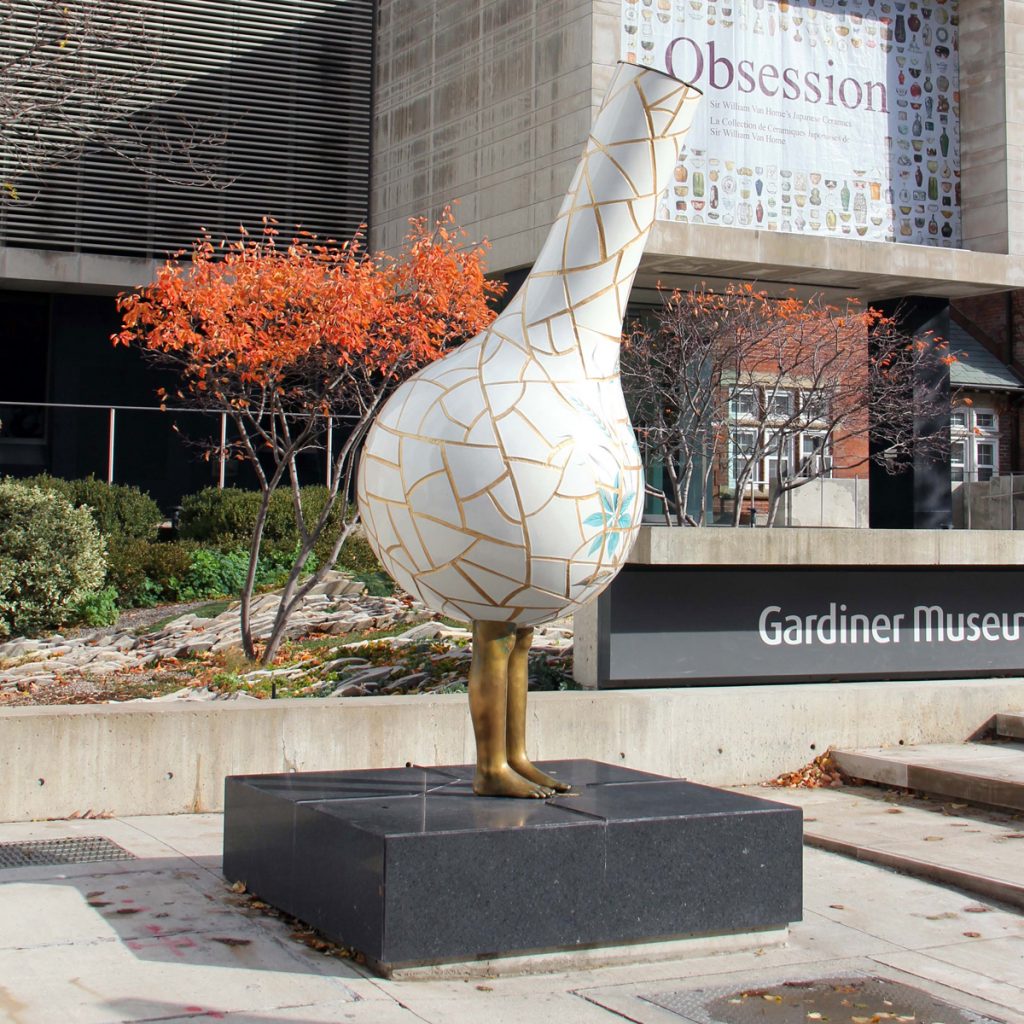Cracked Wheat
In 2018, the Gardiner Museum revealed a new monumental ceramic sculpture by Toronto-based artist Shary Boyle. The sculpture, entitled Cracked Wheat, now sits in front of the Museum on Queen’s Park—a voluptuous cartoon figure to compliment the squat silhouette of the Jun Kaneko “head”, a fixture on the Gardiner Plaza since 2013.
The Gardiner is grateful to La Fondation Emmanuelle Gattuso for commissioning the artwork, and to the City of Toronto and Jane Perdue for their support of the Gardiner Museum’s Ceramic Sculpture Competition.
Artist Statement
My public sculpture on the front grounds of the Gardiner Museum celebrates our human connection to clay. Standing guard as a ceramic museum mascot, Cracked Wheat embodies history on legs.
In consideration of the universal role of ceramics in the human story, I believe a new work of public art at the Gardiner Museum should honour the primary symbol of the functional vessel. Pottery was the first synthetic material created by humans, and our strong relationship to its inherent functionality continues today. Although we now live in an age of industrialized production, the potter’s wheel and the mark of an individual’s hand cannot be divided from the material. Clay has also been rediscovered by a new generation of contemporary artists, and a new audience and artistic relevance has followed. Cracked Wheat embraces the contemporary, historical, and domestic possibilities of the medium.
Standing on an 18-inch granite pedestal, the sculpture tilts provocatively in the direction of the viewer and the street, with a friendly nod towards the Gardiner’s front doors. The sightline of the sculpture matches Jun Kaneko’s plinth, to create a visual symmetry flanking the grounds. As stage-left of the Gardiner is anchored by Kaneko’s ‘head’, stage right is balanced by a clay ‘body’.
In silhouette, Cracked Wheat suggests a voluptuous cartoon figure, a vertical yet curvy Yin to the squat, masculine Yang of Kaneko’s sculpture. Reminiscent of early Renaissance alchemical drawings, the vase (or flask) nods to the experimental chemistry of ceramics, as well as the surrealist distortions of perspective that could result from consuming its contents. Balancing on human legs, it’s uncertain whether the vessel is a costume or a character compound.
Consisting of a 7-foot-tall smashed and restored vase, the painstakingly reassembled pieces reference ancient pottery shards of archeological digs. Like Humpty-Dumpty, its re-combined elements remind us of the extraordinary care taken to preserve an exceptional museum collection of such inherent fragility. The materials and form evoke transformation and alchemy, re-envisioning damaged goods as playful treasure.
Mounted on larger-than‐life childlike legs, the polished bronze and white clay of Cracked Wheat references the 18th-century European decorative tradition of ormolu. A map of gold painted cracks between its 220 unique porcelain shards pays homage to the reinvigorated 16th-century Japanese tradition of Kintsugi, which celebrates breakage, and repair, as part of an object’s history.
Public sculpture should consider site and architecture, but most importantly, generously reflect the public it serves. Ceramics are found in every world culture, within traditions as diverse as the citizens of Toronto. My sculpture is decorated with a vintage “Canadian Wheat” pattern, internationally mass-produced in the 1960s for common, affordable tableware. The relationship between ceramics and food is symbiotic, from ancient pots to a favourite mug. Alongside rice, wheat is the world’s major staple food.
With its broken Canadiana and visible attempts at restoration, Cracked Wheat dares us to confront our complicated relationship to vulnerability, value, and our colonial status. It embodies a hybrid of cultural and ceramic references, iconic simplicity of form and welcoming accessibility: to delight and challenge children, art novices and insiders alike.
About Shary Boyle
Shary Boyle is a Toronto-based artist who works across diverse media, including ceramics, sculpture, painting, installation, and drawing. She represented Canada at the Venice Biennale in 2013, and has held solo exhibitions at the Art Gallery of Ontario, The Power Plant, the Contemporary Art Gallery in Vancouver, and the Institute of Contemporary Art in Philadelphia. Her work has been featured in numerous group shows, including exhibitions at the Gardiner Museum, the National Gallery of Canada, the Musée d’art contemporain de Montreal, the Gyeonggi International Ceramic Biennale in South Korea, MASS MoCA, and Cité de la céramique Sèvres in France.
1. Shary Boyle, Cracked Wheat, 2018.
2. Jun Kaneko, Untitled (head), 2002.

